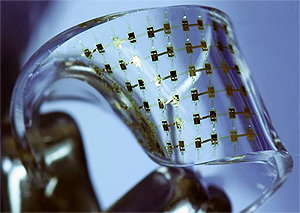 Researchers at the Missouri University of Science and Technology have developed a process to manufacture flexible electronic components using a 3D printed approach. This approach has the potential to replace traditional rugged circuit boards and power electronics such as wearables, vehicle systems, medical devices and more.
Researchers at the Missouri University of Science and Technology have developed a process to manufacture flexible electronic components using a 3D printed approach. This approach has the potential to replace traditional rugged circuit boards and power electronics such as wearables, vehicle systems, medical devices and more.
As smart electronics become more complex, manufacturers are tasked to fit more components into smaller areas to keep up with current trends. Incorporating stretchable electronic components enables these devices to be elongated or twisted while still operating flawlessly.
The key to this technology lies within the unique surface of the circuit board, known as elastomer, a clear material that houses all of the electronic components. Using a process called additive manufacturing, the team creates three-dimensional objects layer-by-layer, similar to 3D printing. Using this process, the team is able to print very thin layers of conductive material onto the elastomer, without it breaking or losing power.
Currently the team is looking into the development of a stretchable battery containing the same properties and lifespan of the circuit board to provide power within these devices. Once developed, this technology could create countless opportunities for the future applications of stretchable electronics.
At Eclipse, we understand the importance of maintaining a competitive edge, especially in fast-evolving industries like electronics and automotive. Eclipse partners with top tech companies around the world to enhance its knowledge and expertise, providing the best services and products that enable you to continuously evolve and adapt in an increasingly complex business environment.
Source: Missouri S&T
